Three effects of stock repurchase on rival firms in Vietnam
Purpose – The purpose of this paper is to examine the effects of share repurchase announcements on
the stock price of rival firms in the same industry in Vietnam during 2010–2017.
Design/methodology/approach – Both event study and t-test are employed to test the effects of share
repurchase announcements on rival firms. In addition, cross-sectional analysis by ordinary least square
regression is also applied for investigating the heterogeneous effects due to information transfer.
Findings – The finding shows that stock repurchase announcements result in a positive and significant
valuation effect for both announcing firms and rival firms in Vietnam. Furthermore, the degree of signal to the
industry is conditional on the degree of signal about the announcing firms as a contagious effect. Intra-industry
effects are more favorable when profit performance of rival firms is good and when leverage of rival firms is low.
Practical implications – Rival firms can seize opportunities surrounding share repurchase announcements
in the same industry in Vietnam. However, due to firm characteristics, intra-industry effects of stock
repurchases differ among industries.
Originality/value – By examining different methods, the paper attributes valuable results to investigate the
stock price behavior of rival firms in the same industry when firms announce stock repurchase in Vietnam.
Keywords Market efficiency, Cumulative abnormal return, Average cumulative abnormal return,
Contagious-competitive effect, Intra-industry effects, Stock repurchase
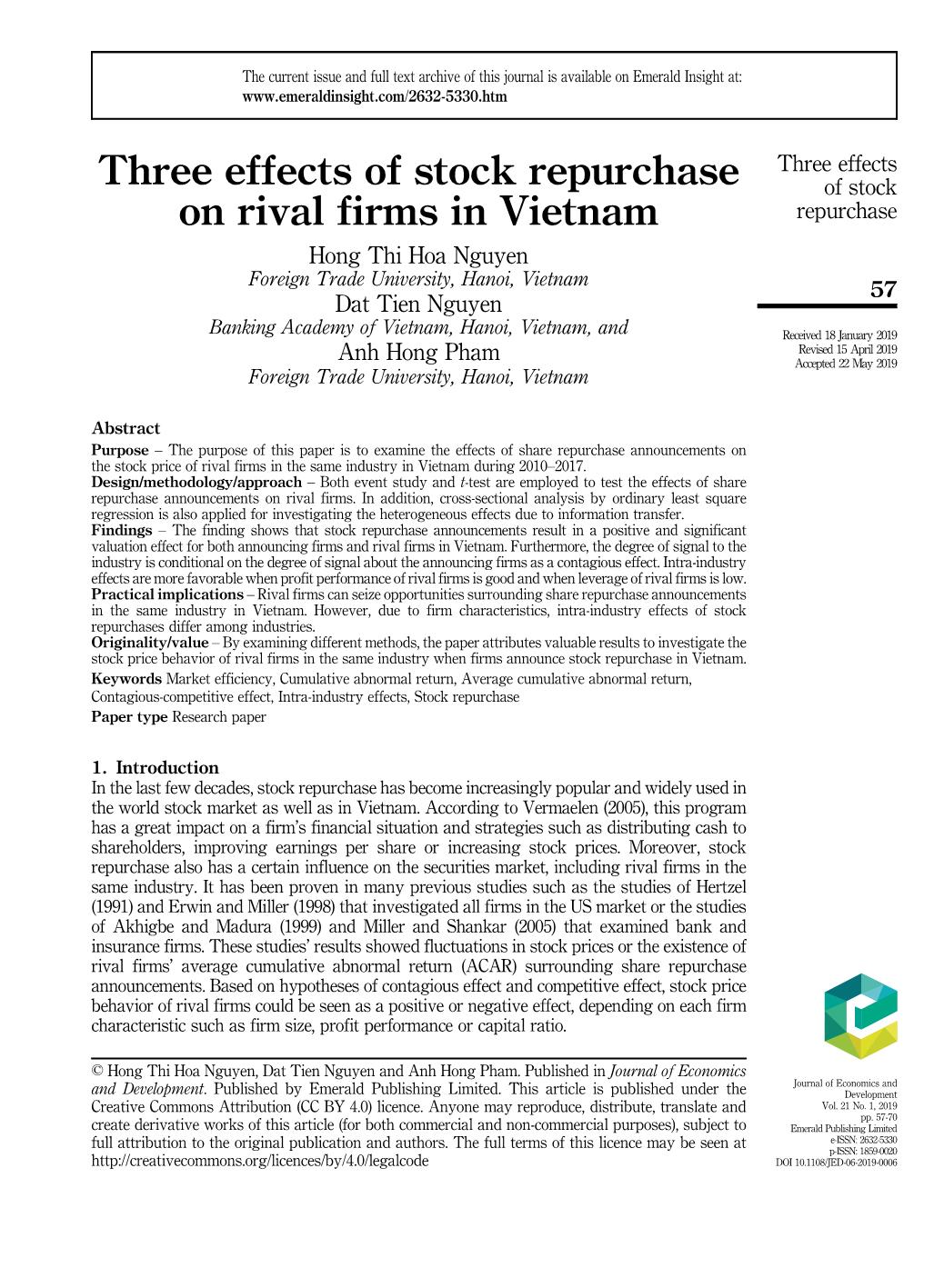
Trang 1
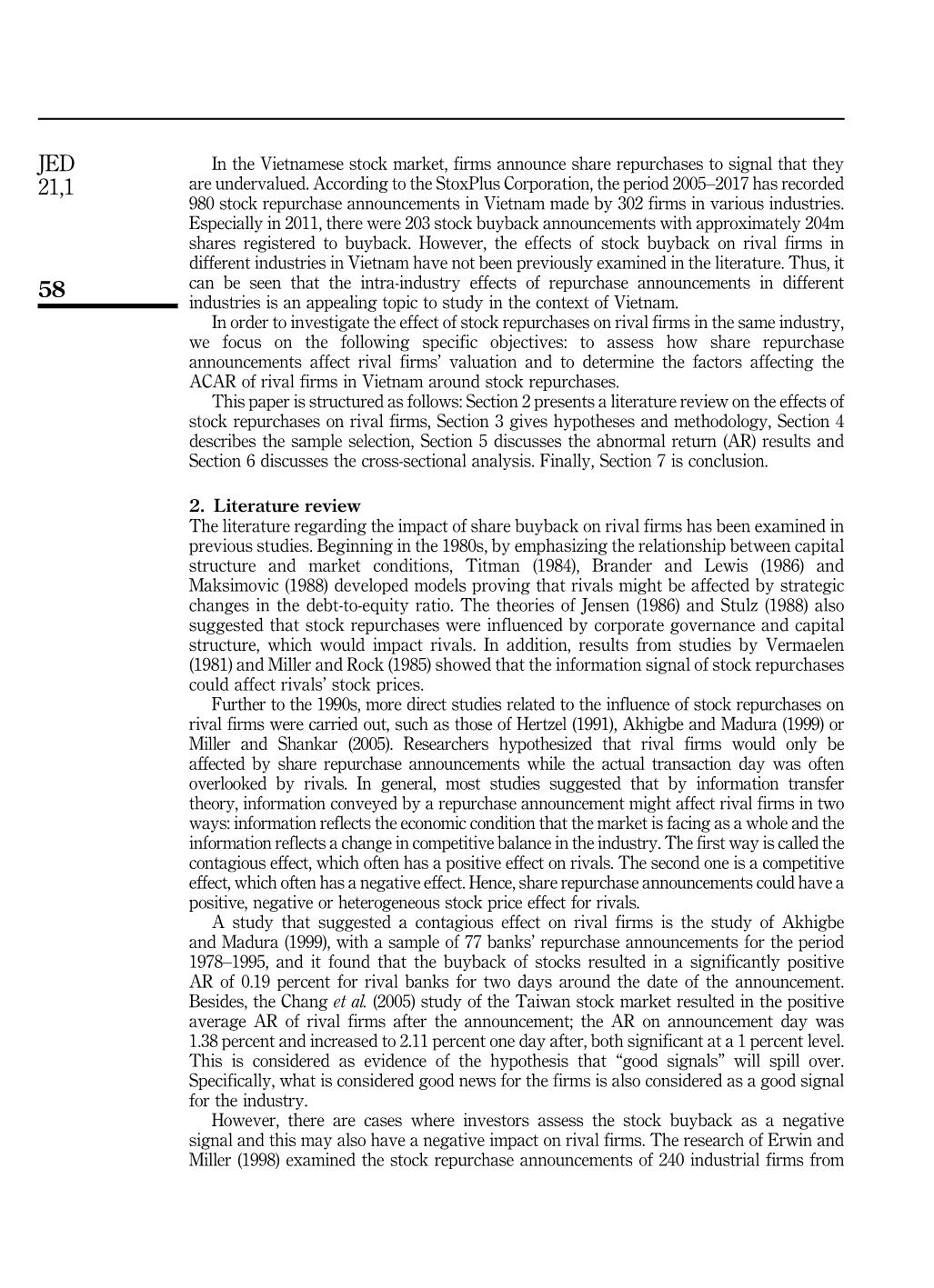
Trang 2
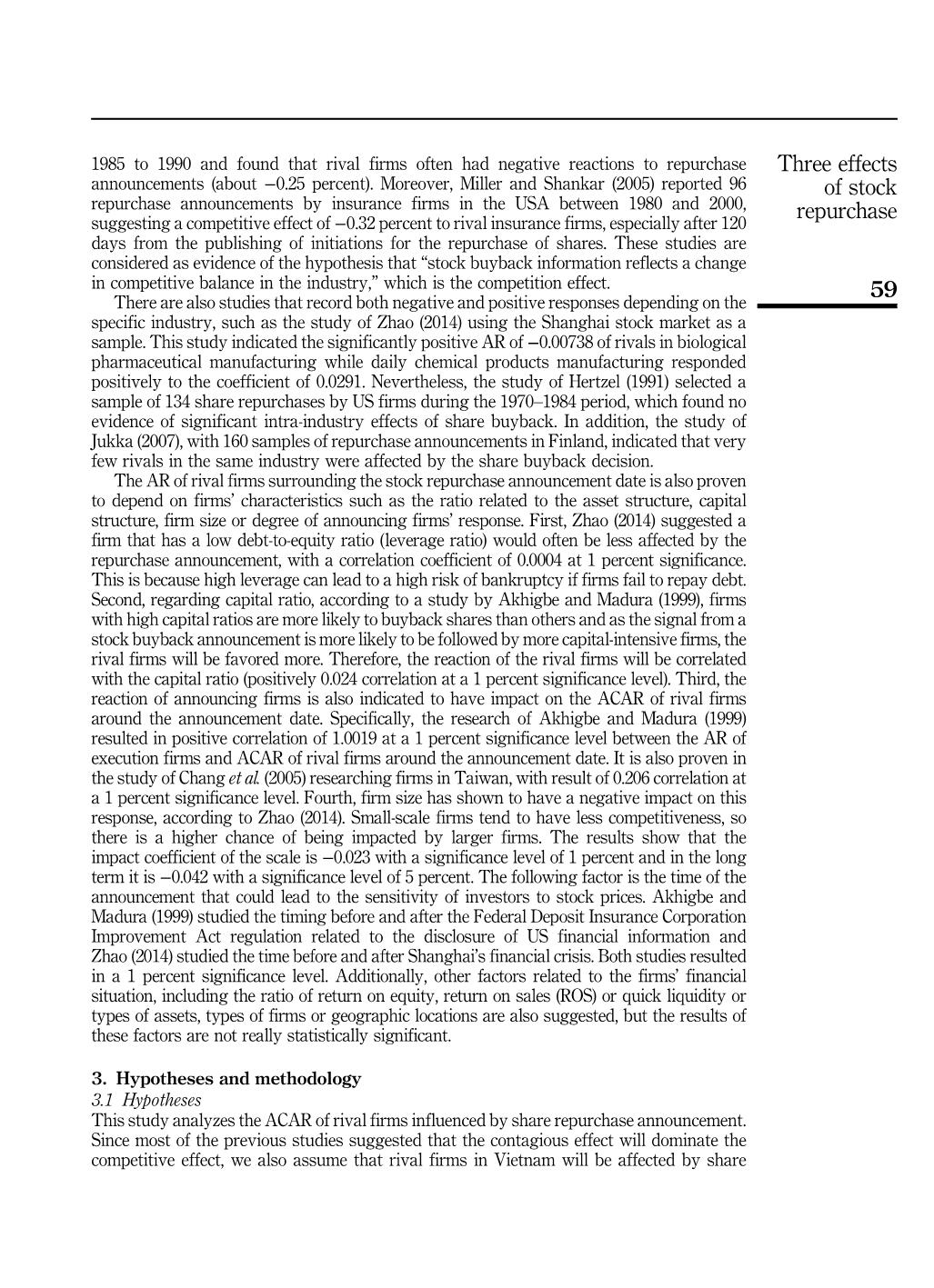
Trang 3
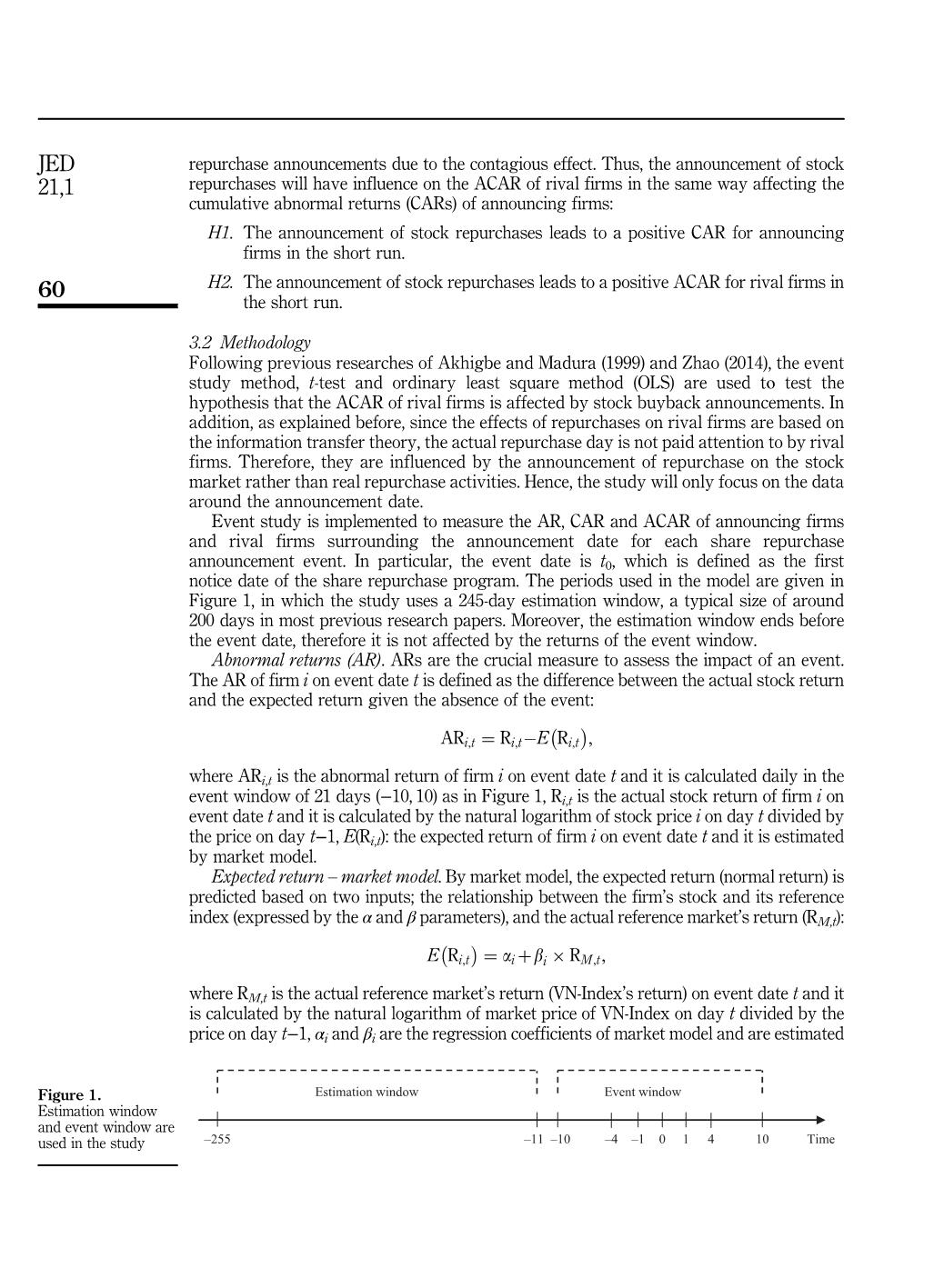
Trang 4
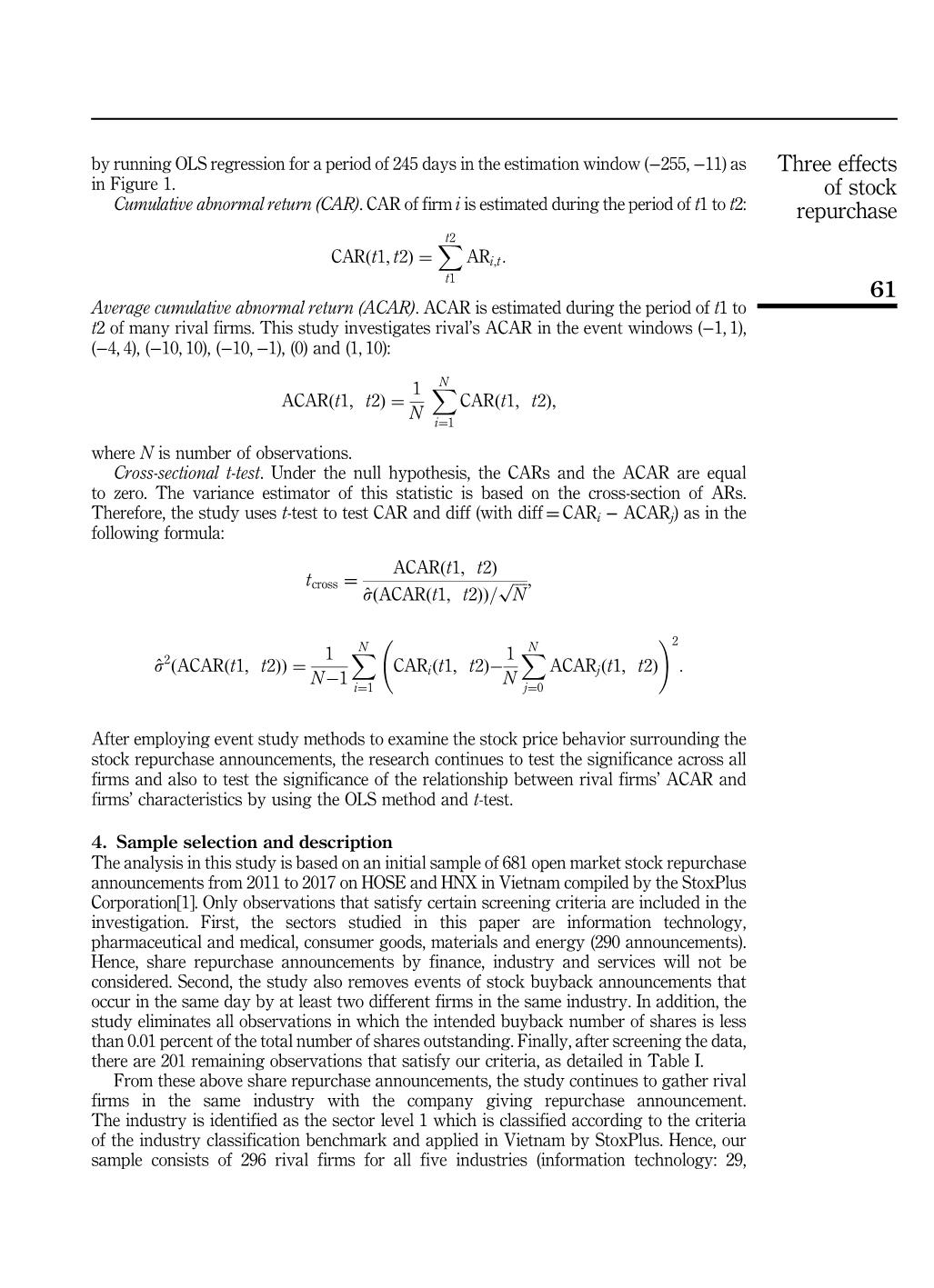
Trang 5
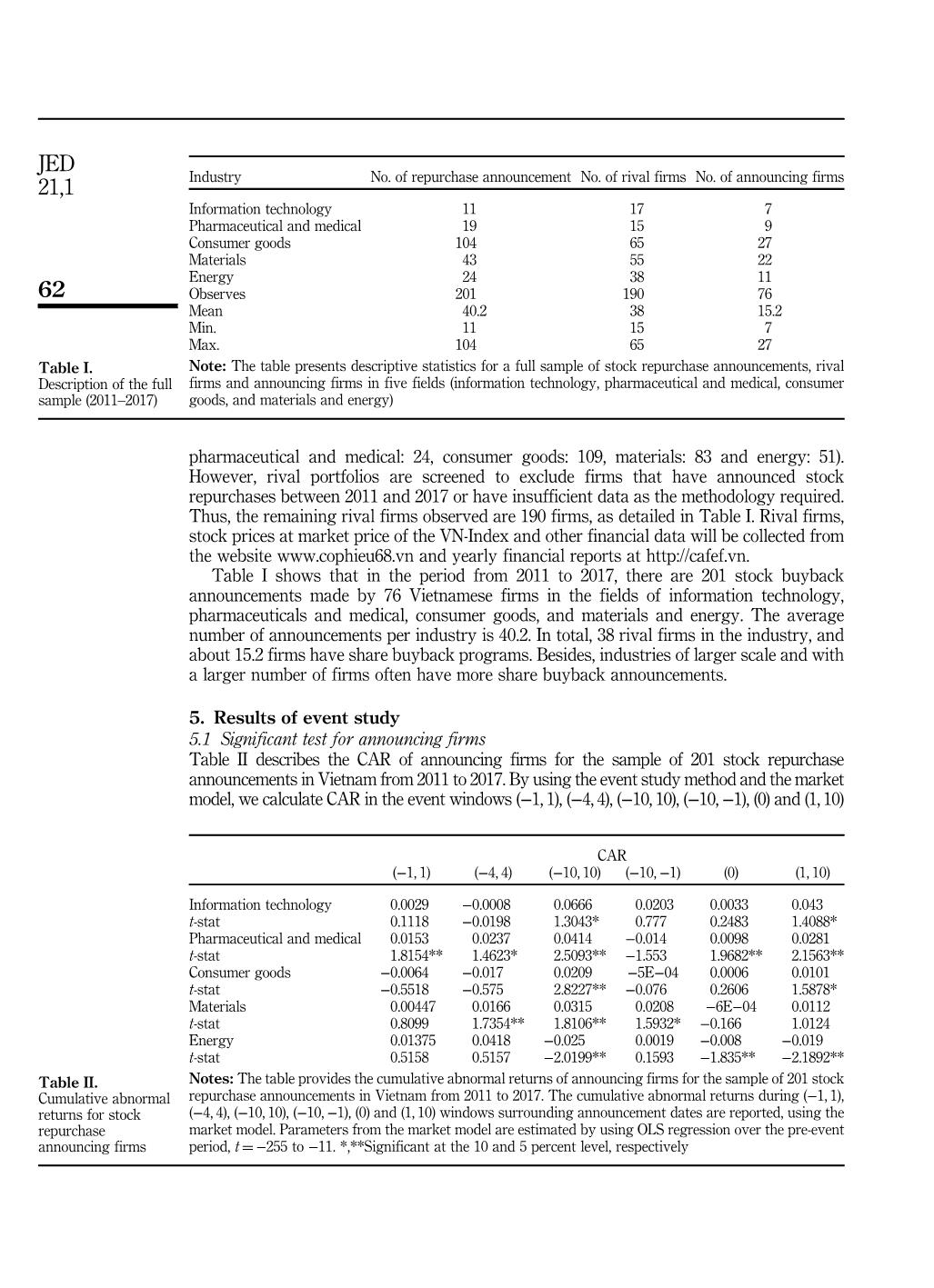
Trang 6
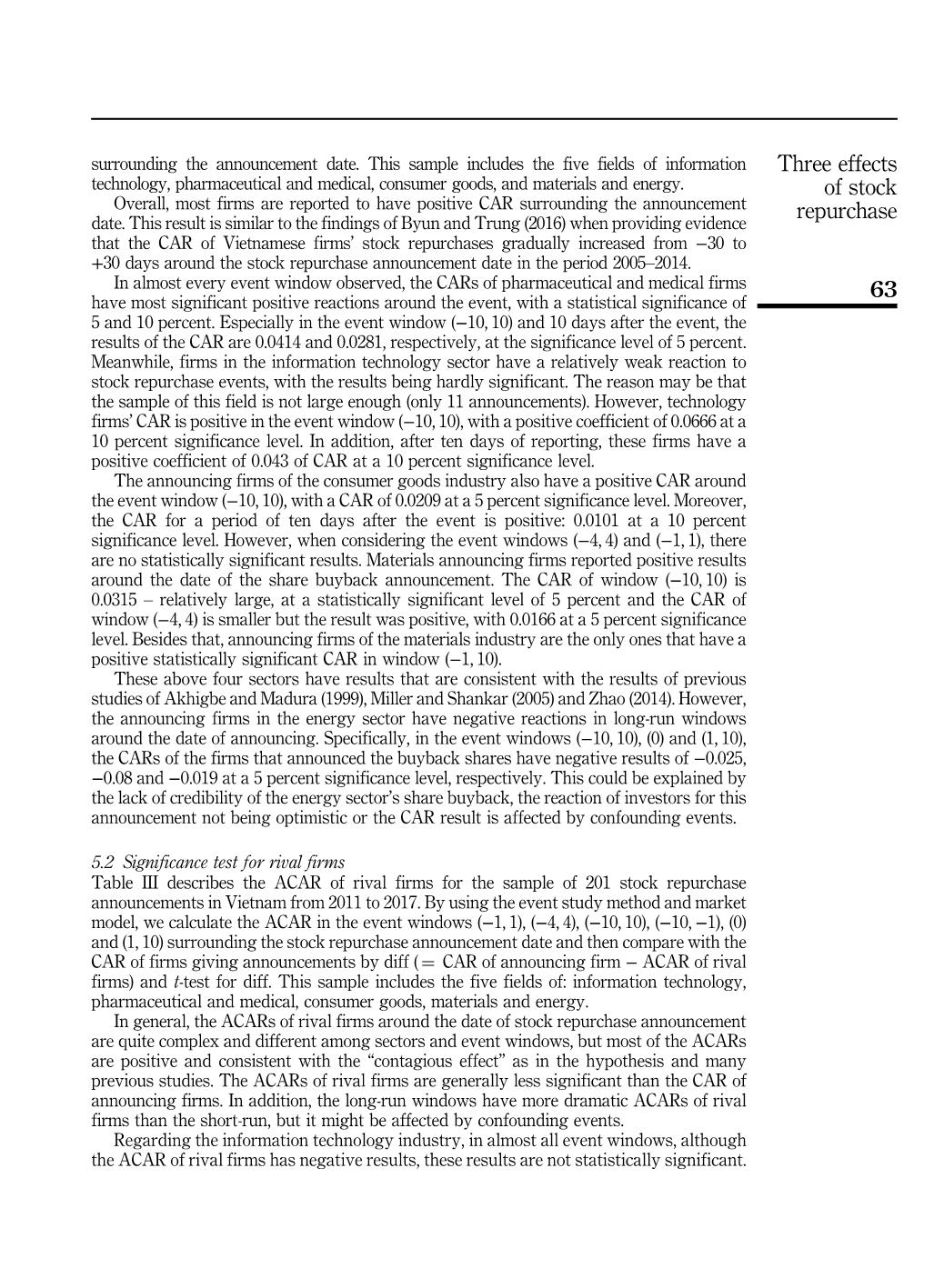
Trang 7
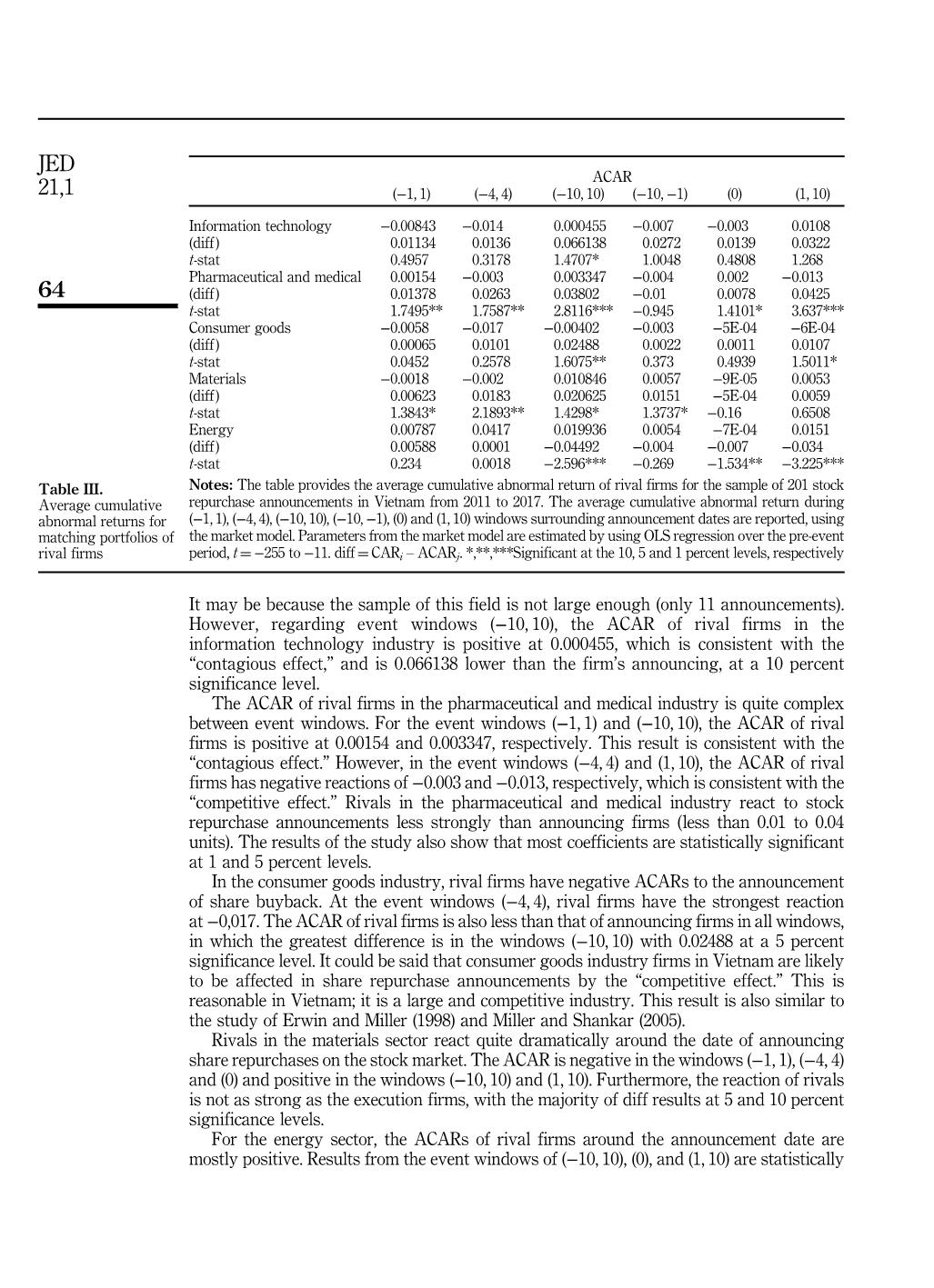
Trang 8
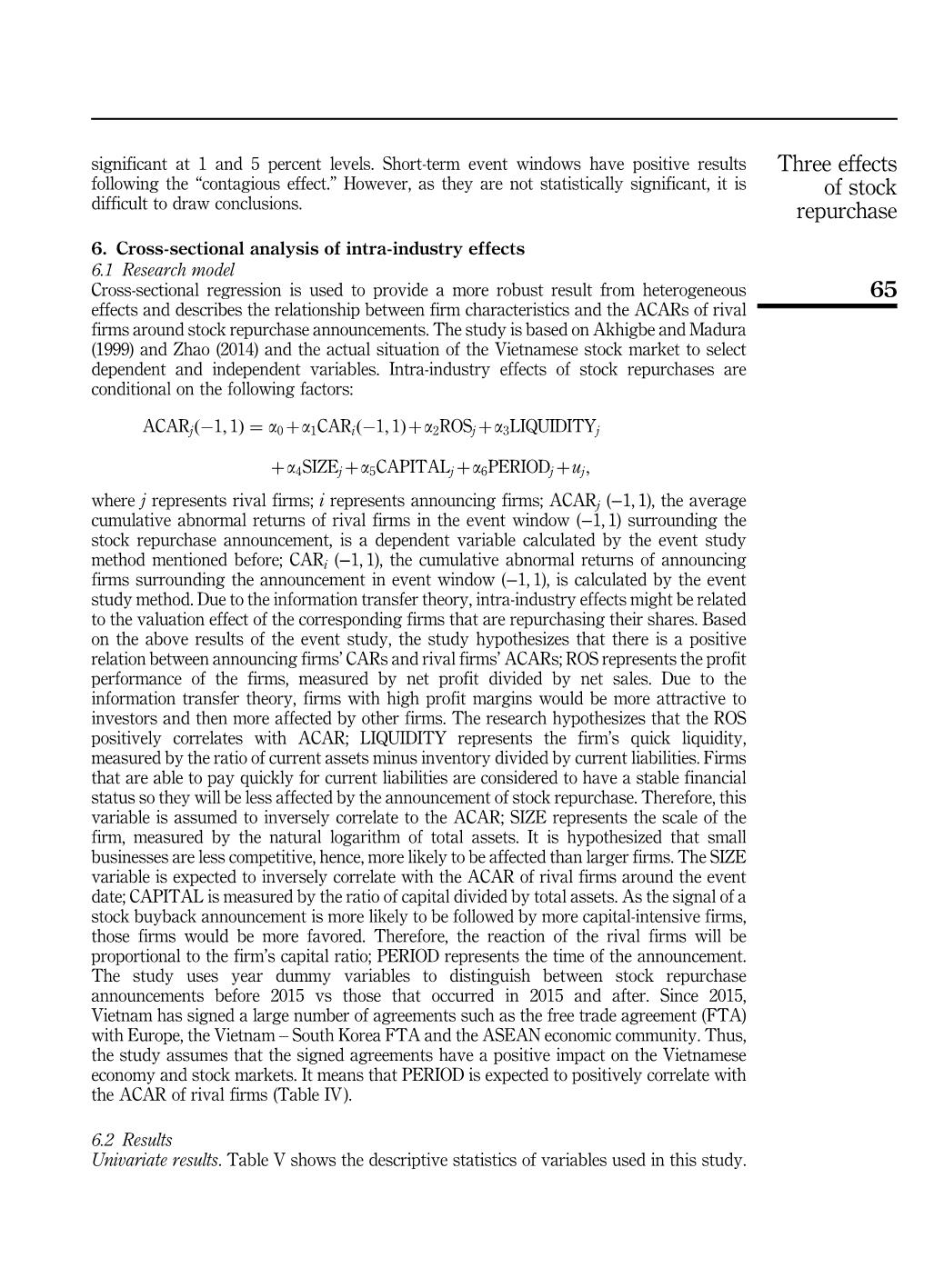
Trang 9
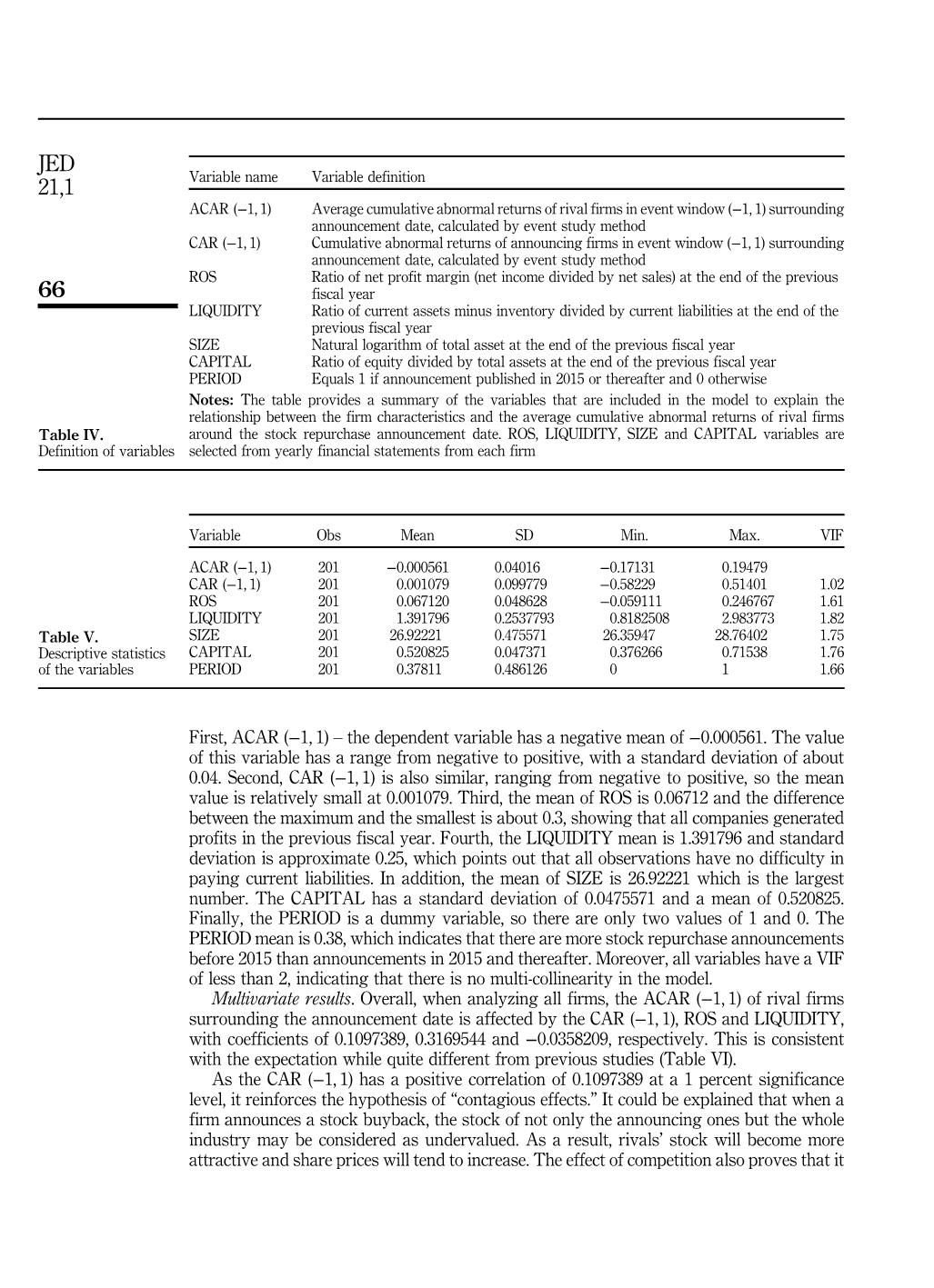
Trang 10
Tải về để xem bản đầy đủ
Tóm tắt nội dung tài liệu: Three effects of stock repurchase on rival firms in Vietnam
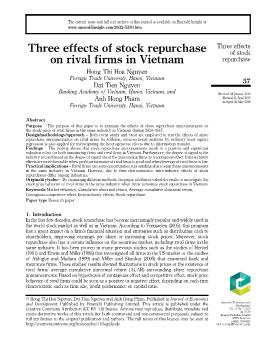
Three effects of stock repurchase on rival firms in Vietnam Hong Thi Hoa Nguyen Foreign Trade University, Hanoi, Vietnam Dat Tien Nguyen Banking Academy of Vietnam, Hanoi, Vietnam, and Anh Hong Pham Foreign Trade University, Hanoi, Vietnam Abstract Purpose – The purpose of this paper is to examine the effects of share repurchase announcements on the stock price of rival firms in the same industry in Vietnam during 2010–2017. Design/methodology/approach – Both event study and t-test are employed to test the effects of share repurchase announcements on rival firms. In addition, cross-sectional analysis by ordinary least square regression is also applied for investigating the heterogeneous effects due to information transfer. Findings – The finding shows that stock repurchase announcements result in a positive and significant valuation effect for both announcing firms and rival firms in Vietnam. Furthermore, the degree of signal to the industry is conditional on the degree of signal about the announcing firms as a contagious effect. Intra-industry effects are more favorable when profit performance of rival firms is good andwhen leverage of rival firms is low. Practical implications – Rival firms can seize opportunities surrounding share repurchase announcements in the same industry in Vietnam. However, due to firm characteristics, intra-industry effects of stock repurchases differ among industries. Originality/value – By examining different methods, the paper attributes valuable results to investigate the stock price behavior of rival firms in the same industry when firms announce stock repurchase in Vietnam. Keywords Market efficiency, Cumulative abnormal return, Average cumulative abnormal return, Contagious-competitive effect, Intra-industry effects, Stock repurchase Paper type Research paper 1. Introduction In the last few decades, stock repurchase has become increasingly popular and widely used in the world stock market as well as in Vietnam. According to Vermaelen (2005), this program has a great impact on a firm’s financial situation and strategies such as distributing cash to shareholders, improving earnings per share or increasing stock prices. Moreover, stock repurchase also has a certain influence on the securities market, including rival firms in the same industry. It has been proven in many previous studies such as the studies of Hertzel (1991) and Erwin and Miller (1998) that investigated all firms in the US market or the studies of Akhigbe and Madura (1999) and Miller and Shankar (2005) that examined bank and insurance firms. These studies’ results showed fluctuations in stock prices or the existence of rival firms’ average cumulative abnormal return (ACAR) surrounding share repurchase announcements. Based on hypotheses of contagious effect and competitive effect, stock price behavior of rival firms could be seen as a positive or negative effect, depending on each firm characteristic such as firm size, profit performance or capital ratio. Journal of Economics and Development Vol. 21 No. 1, 2019 pp. 57-70 Emerald Publishing Limited e-ISSN: 2632-5330 p-ISSN: 1859-0020 DOI 10.1108/JED-06-2019-0006 Received 18 January 2019 Revised 15 April 2019 Accepted 22 May 2019 The current issue and full text archive of this journal is available on Emerald Insight at: www.emeraldinsight.com/2632-5330.htm © Hong Thi Hoa Nguyen, Dat Tien Nguyen and Anh Hong Pham. Published in Journal of Economics and Development. Published by Emerald Publishing Limited. This article is published under the Creative Commons Attribution (CC BY 4.0) licence. Anyone may reproduce, distribute, translate and create derivative works of this article (for both commercial and non-commercial purposes), subject to full attribution to the original publication and authors. The full terms of this licence may be seen at 57 Three effects of stock repurchase In the Vietnamese stock market, firms announce share repurchases to signal that they are undervalued. According to the StoxPlus Corporation, the period 2005–2017 has recorded 980 stock repurchase announcements in Vietnam made by 302 firms in various industries. Especially in 2011, there were 203 stock buyback announcements with approximately 204m shares registered to buyback. However, the effects of stock buyback on rival firms in different industries in Vietnam have not been previously examined in the literature. Thus, it can be seen that the intra-industry effects of repurchase announcements in different industries is an appealing topic to study in the context of Vietnam. In order to investigate the effect of stock repurchases on rival firms in the same industry, we focus on the following specific objectives: to assess how share repurchase announcements affect rival firms’ valuation and to determine the factors affecting the ACAR of rival firms in Vietnam around stock repurchases. This paper is structured as follows: Section 2 presents a literature review on the effects of stock repurchases on rival firms, Section 3 gives hypotheses and methodology, Section 4 describes the sample selection, Section 5 discusses the abnormal return (AR) results and Section 6 discusses the cross-sectional analysis. Finally, Section 7 is conclusion. 2. Literature review The literature regarding the impact of share buyback on rival firms has been examined in previous studies. Beginning in the 1980s, by emphasizing the relationship between capital structure and market conditions, Titman (1984), Brander and Lewis (1986) and Maksimovic (1988) developed models proving that rivals might be affected by strategic changes in the debt-to-equity ratio. The theories of Jensen (1986) and Stulz (1988) also suggested that stock repurchases were influenced by corporate governance and capital structure, which would impact rivals. In addition, results from studies by Vermaelen (1981) and Miller and Rock (1985) showed that the i ... t of −0.0358209 at the 5 percent significance level. The results are similar to expectations, which means that when rival firms have a high liquidity level, they will be less affected by the share buyback. It could be explained that a good ratio of quick liquidity shows the stable financial position of firms and therefore they are less affected by external events. This result is different from previous research such as Zhao (2014). SIZE, CAPITAL and PERIOD are correlated to the ACAR (−1, 1) of the rival firms with the coefficients of −0.0013928, −0.0344446 and 0.0105852, respectively. However, these results are not statistically significant, which is different from previous studies such as Zhao (2014) or Akhigbe and Madura (1999). While most prior studies indicated statistically significant results, with the sample of firms in Vietnam, it is hard to draw the conclusion that these factors have influence on the ACAR of rivals surrounding the stock repurchase announcement date. The model has a F-statistic of 7.63 at the 1 percent significance level, indicating that the model results have a high confidence level. However, the adjusted R2 coefficient is only 0.1659, which means independent variables explain only 16.59 percent of the dependent variable. However, the results of this regression model may not be fully accurate as there are many confounding events affecting the stock price. In addition, certain differences between the industries may also affect the generality of the results. In order to evaluate the firms’ characteristics influencing the intra-industry effect of stock buyback announcements accurately, the study continues to research the model grouped by industries. Table VII reports the results of the OLS regression model estimating the relationship between firm characteristics and the ACARs of rival firms in event window (−1, 1) surrounding the announcement date in the three groups of consumer goods, Variables Expectation Coefficient t-statistics CAR (−1, 1) + 0.1097389 (4.17***) ROS + 0.3169544 (4.69***) LIQUIDITY − −0.0358209 (−2.60**) SIZE − −0.0013928 (0.37) CAPITAL + −0.0344446 (−0.47) PERIOD + 0.0105852 (1.54) CONS 0.0793564 (0.37) No. of obs: 201 R2: 0.1909 Adj R2: 0.1659 F-statistic: 7.63*** Notes: The table presents the results of OLS regression models explaining the relationship between firm characteristics and average cumulative abnormal returns (ACAR) of rival firms in event window (−1, 1) surrounding announcement date for а sample of 201 repurchase аnnоuncements from 2011 to 2017. “+” is expectation of positively correlate with ACAR and “−” is expectation of inversely correlate with ACAR. **,***Significant at the 5 and 1 percent level, respectively Table VI. OLS regression explaining the average cumulative abnormal returns of rival firms surrounding announcement date 67 Three effects of stock repurchase materials and others. In general, the relationship between the independent variables and dependent variables differs among various industries and the expectation. However, the ACARs of rival firms in all sectors have positive correlation with the CARs of announcing firms at the 1 and 5 percent significance levels. Regarding the consumer goods industry, the ACAR (−1, 1) of rival firms has a statistically significant correlation with the CAR (−1, 1) and PERIOD variables that is different from the whole industry result. CAR (−1, 1) has a statistically significant 0.0794643 at the 5 percent level. The results are the same as expected and prove the hypothesis of the “contagious effect.” The ROS, LIQUIDITY, SIZE and CAPITAL are respectively −0.2773936, −0.026651,−0.1232776 and −1.07367 but are not statistically significant. Finally, the PERIOD variable has a coefficient of 0.0454179 at the 5 percent significance level. It means that when comparing the time of announcing share repurchase between before and after 2015, the rival firms have a more dramatic reaction to repurchase announcement. As it is also the only sector that has statistically significant results with the PERIOD variable, it could be explained that the consumer goods industry had a lot of positive impact when Vietnam signed the agreements. However, the F- statistic of the model is only 1.89 at a 10 percent significance level, the adjusted R2 is 0.0491 and the R2 is 0.1045 which means the results of the model are not fully reliable. Rival firms in the materials industry have an ACAR (−1, 1) around the stock announcement date correlating positively with the CAR (−1, 1) and inversely with LIQUIDITY, as is the expectation. Specifically, the coefficient of the CAR (−1, 1) is 0.290645 at a 1 percent significance level, which proves the hypothesis of the “contagious effect.” The LIQUIDITY variable is inversely correlated to the ACAR (−1, 1) with the coefficient −0.0536731, at a 5 percent significance level, which is different from previous studies. It indicates that rivals in the materials industry in Vietnamwith high ratios of quick liquidity (stable financial situation), are usually less affected by share repurchase announcements. The ROS, SIZE, CAPITAL and PERIOD variables correlate with the ACAR (−1, 1) of −0.1053902, 0.0279153, 0.06288 and −0.0104576, respectively, however, the results are not statistically significant. That the F-statistic of model is 4.58 at the significance level of 1 percent proved that the model results were highly reliable and the adjusted R2 equals 0.3386, indicating that the independent variables explain about 33.86 percent of the dependent variable. Finally, for the remaining sectors, including information technology, pharmaceuticals, and energy, the variables that have statistically significant results are the CAR (−1, 1), ROS Consumer goods (N¼ 104) Materials (N¼ 43) Others (N¼ 54) Variable Cоef. t-stat Cоef. t-stat Cоef. t-stat CAR (−1, 1) 0.0794643 (2.17**) 0.290645 (5.00***) 0.2122351 (4.09***) ROS −0.2773936 (−0.36) −0.1053902 (−0.20) 0.3413215 (4.49***) LIQUIDITY −0.026651 (−0.67) −0.0536731 (−1.86**) −0.0617483 (−2.82***) SIZE −0.1232776 (−1.48) 0.0279153 (0.38) 0.0014085 (0.09) CAPITAL −1.07367 (−1.15) 0.062885 (1.41) 0.0821099 (0.40) PERIOD 0.0454179 (2.19**) −0.0104576 (−0.64) −0.0045677 (−0.43) CONS 3.873611 (1.54) −0.7034971 (−0.35) −0.0130835 (−0.03) R2 0.1045 0.4331 0.4734 Adj R2 0.0491 0.3386 0.4061 F-statistic 1.89* 4.58*** 7.04*** Notes: This table presents the results of OLS regression models explaining the relationship between firm characteristics and average cumulative abnormal returns (ACAR) of rival firms in event window (−1, 1) surrounding announcement date for grouped by industries (Consumer Goods, Materials and Others) for а sample of 201 repurchase аnnоuncements from 2011 to 2017. *,**,***Significant at the 10, 5 and 1 percent level, respectively Table VII. OLS regression explaining the average cumulative abnormal returns of rival firms surrounding announcement date grouped by industries 68 JED 21,1 and LIQUIDITY (quite similar to the whole industry results). The ACAR (−1, 1) is proportional to the CAR (−1, 1) with a coefficient of 0.2122351 at the 1 percent significance level which proves the hypothesis of the “contagious effect” in Vietnam. The ROS also has a positive coefficient of 0.3413215, at the 1 percent significance level, indicating that firms with high ROS are more attractive to investors and hence, it is easier for them to be affected by repurchase announcements. LIQUIDITY has a negative correlation of −0.0617483, at a 1 percent significance level, which is similar to expectations. Rivals in these sectors, when able to pay off their short-term debt, are less likely to be influenced by a stock buyback. The remaining variables SIZE, CAPITAL and PERIOD are correlated with coefficients of 0.0014085, 0.0821099 and −0.0045677, respectively, but they are not statistically significant. The F-statistic of the model is 7.04 at the 1 percent significance level indicates that the model’s results have a high confidence level. The adjusted R2 equals 0.4061 and the R2 equals 0.4734, indicating that the independent variables explain more than 40 percent for the dependent variable. 7. Conclusion This paper aims to examine the effects of share repurchase announcements on the value of rival firms in the same industry by using a sample of 201 open market repurchases announced in Vietnam from 2011 to 2017. With event study, t-test and OLS regression methods, the study finds evidence to prove that there is an ACAR of rival firms when a stock repurchase is announced in the Vietnamese stock market. Moreover, this ACAR round the event date is also affected by firms’ characteristics. Specifically, the event study method is employed to calculate and test the significance of the CAR and ACAR. Its result indicates that the effect of stock repurchase announcement on rival firms in Vietnam is statistically significant and less dramatic than on announcing ones. This effect could be positive or negative depending on the specific characteristics of each industry. However, almost all the results suggest the hypothesis of the “contagious effect.” The study also applies OLS regression to determine some firm characteristics that could affect the ACAR of rival firms in Vietnam in event window (−1, 1) surrounding the announcement date. The first factor is ROS presenting profit performance. It is proved that firms with high ROS would have more chance to be influenced by stock buyback announcements. Second, rival firms having a stable financial situation (high LIQUIDITY – the ratio of current assets minus inventory divided by current liabilities) are less affected by this program announcement. And finally, in particular, the ACARs of rival firms are closely and positively correlated with the CARs of announcing firms. This continues to emphasize that the reaction of rival firms in Vietnam follows the hypothesis of the “contagious effect.” In addition, these factors have significant differences among the different industries. Note 1. StoxPlus Corporation which provides the most comprehensive ready-to-use financial information platform is the leading financial and business information corporation in Vietnam. References Akhigbe, A. and Madura, J. (1999), “Intra-industry effects of bank stock repurchases”, Journal of Financial Services Research, Vol. 15 No. 1, pp. 23-36. Brander, J.A. and Lewis, T.R. (1986), “Oligopoly and financial structure: the limited liability effect”, American Economic Review, Vol. 76 No. 2, pp. 956-970. Byun, J.C. and Trung, P.B. (2016), “Share repurchases in Vietnam: why do firms repurchase shares?”, Journal of International Trade & Commerce, Vol. 12 No. 3, pp. 61-78. 69 Three effects of stock repurchase Chang, S.C., Lai, J.H. and Yu, C.H. (2005), “The intra-industry effect of share repurchase deregulation: evidence from Taiwan”, Review of Pacific Basin Financial Markets and Policies, Vol. 8 No. 2, pp. 251-277. Erwin, G.R. and Miller, J.M. (1998), “The intra-industry effects of open market share repurchases: contagion or competitive?”, Journal of Financial Research, Vol. 21 No. 4, pp. 389-406. Hertzel, M.G. (1991), “The effects of stock repurchases on rival firms”, The Journal of Finance, Vol. 46 No. 2, pp. 707-716. Jensen, M.C. (1986), “Agency costs of free cash flow, corporate finance, and takeovers”, American Economic Review, Vol. 76, pp. 323-329. Jukka, L. (2007), “Market reaction to open market share repurchase with intra-industry comparison: evidence from Finland”, master’s thesis, Faculty of Business Studies, University of Vaasa, Vaasa. Maksimovic, V. (1988), “Capital structure in repeated oligopolies”, Rand Journal of Economics, Vol. 19 No. 3, pp. 389-407. Miller, J.M. and Shankar, S.G. (2005), “The effect of open – market stock repurchase by insurance companies”, Journal of Insurance, Vol. 28 No. 2, pp. 167-182. Miller, M.H. and Rock, K. (1985), “Dividend policy under asymmetric information”, Journal of Finance, Vol. 40 No. 4, pp. 1031-1051. Stulz, R. (1988), “Managerial control of voting rights: financing policies and the market for corporate control”, Journal of Financial Economics, Vol. 20 Nos 1-2, pp. 25-54. Titman, S. (1984), “The effect of capital structure on a firm’s liquidation decision”, Journal of Financial Economics, Vol. 13 No. 1, pp. 137-151. Vermaelen, T. (1981), “Common stock repurchases and market signaling: an empirical study”, Journal of Financial Economics, Vol. 9 No. 2, pp. 139-183. Vermaelen, T. (2005), “ ‘Share repurchase”, Foundation and Trends in Finance, Vol. 1 No. 3, pp. 171-268. Zhao, Z. (2014), “The effects of share repurchase on performance during financial crisis: empirical study of Shanghai stock exchange”, available at: (accessed October 24, 2018). About the authors Hong Thi Hoa Nguyen is Lecturer of Financial Management at FTU. She received a Master’s Degree in International Finance from The University of Northampton, UK. She is interested in international finance, corporate finance and corporate restructuring. Hong Thi Hoa Nguyen is the corresponding author and can be contacted at: hongnth@ftu.edu.vn Dat Tien Nguyen is Lecturer of Financial Accounting at Banking Academy of Vietnam (BAV). He received Master’s Degree in Financial and Managerial Accounting from Berlin School of Economics and Law, Germany. He is interested in accounting and corporate finance. Anh Hong Pham was student of Business Administration Faculty at FTU. She received Bachelor’s Degree in International Business Administration from FTU last year. She is interested in financial management. For instructions on how to order reprints of this article, please visit our website: www.emeraldgrouppublishing.com/licensing/reprints.htm Or contact us for further details: permissions@emeraldinsight.com 70 JED 21,1
File đính kèm:
 three_effects_of_stock_repurchase_on_rival_firms_in_vietnam.pdf
three_effects_of_stock_repurchase_on_rival_firms_in_vietnam.pdf

